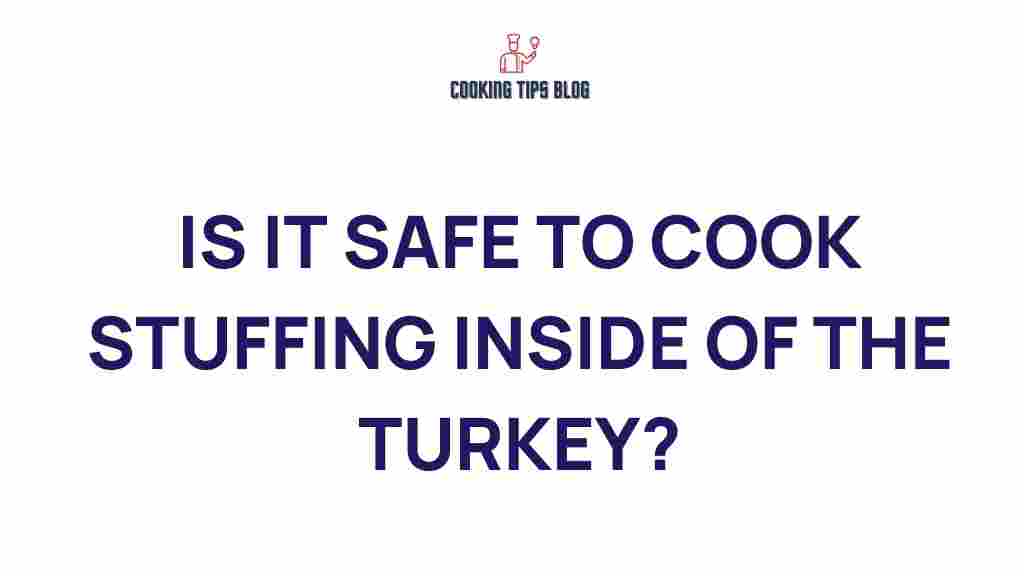Is Cooking Stuffing Inside Your Turkey Safe? The Truth Revealed
Thanksgiving is a time for family gatherings, delicious food, and cherished traditions. One of the most enduring traditions is the preparation of turkey, often accompanied by a savory stuffing. However, the question arises: is cooking stuffing inside your turkey safe? In this article, we will explore the topic of turkey stuffing safety, providing you with everything you need to know to ensure a safe and enjoyable holiday feast.
The Basics of Turkey Stuffing Safety
When it comes to cooking a turkey, safety should always be a priority. The USDA (United States Department of Agriculture) provides guidelines to help ensure that your holiday meal is both delicious and safe. Understanding these guidelines can help prevent foodborne illnesses.
- Temperature Control: Keeping food at safe temperatures is crucial. Stuffing should be cooked to a minimum internal temperature of 165°F (73.9°C).
- Cooking Time: The cooking time for turkey can vary depending on its size. A stuffed turkey will generally require a longer cooking time than an unstuffed one.
- Moisture and Ingredients: The ingredients in your stuffing can affect its safety. Moist stuffing made with broth or gravy can harbor bacteria if not cooked properly.
Is It Safe to Cook Stuffing Inside the Turkey?
The short answer is yes, but with conditions. Cooking stuffing inside your turkey can enhance flavor, as the stuffing absorbs juices and flavors from the turkey. However, turkey stuffing safety relies heavily on proper preparation and cooking techniques.
Here are some important considerations:
- Use Fresh Ingredients: Always use fresh, high-quality ingredients in your stuffing. Avoid using stale bread or expired items.
- Prepare Stuffing Just Before Cooking: Stuffing should be prepared just before you place it inside the turkey. This helps reduce the risk of bacterial growth.
- Pack It Loosely: When stuffing your turkey, do not pack the stuffing too tightly. This allows for even cooking and helps the stuffing reach the safe temperature of 165°F.
Step-by-Step Guide to Safely Stuffing Your Turkey
If you decide to stuff your turkey, follow this step-by-step guide to ensure turkey stuffing safety:
- Prepare Your Ingredients: Gather fresh ingredients for your stuffing, including bread, vegetables, herbs, and stock.
- Make the Stuffing: Combine your ingredients in a bowl. If using meat, ensure it is cooked beforehand.
- Preheat Your Oven: Set your oven to 325°F (162°C). This is the ideal temperature for roasting a turkey safely.
- Stuff the Turkey: Spoon the prepared stuffing loosely into the turkey’s cavity, ensuring it is not packed too tightly.
- Truss and Roast: Tie the legs together and tuck the wings under the body. Place the turkey in a roasting pan and put it in the oven.
- Check the Temperature: Use a meat thermometer to check the internal temperature of the stuffing and turkey. Both should reach at least 165°F.
- Let It Rest: After removing the turkey from the oven, let it rest for at least 20 minutes before carving.
Common Mistakes to Avoid
Even with the best intentions, mistakes can happen in the kitchen. Here are some common pitfalls to avoid when it comes to turkey stuffing safety:
- Stuffing Too Early: Preparing your stuffing too far in advance can lead to bacterial growth. Always stuff your turkey just before cooking.
- Not Using a Thermometer: Relying on cooking times alone can be misleading. Always use a meat thermometer to ensure food safety.
- Packing the Stuffing Tightly: As mentioned earlier, tightly packed stuffing may not cook evenly, leading to unsafe temperatures.
Troubleshooting Tips
Despite your best efforts, issues may arise during the cooking process. Here are some troubleshooting tips to navigate common problems:
- If the Stuffing Is Not Cooking: If the stuffing is not reaching 165°F, increase the oven temperature slightly and cover the turkey with foil to help it cook evenly.
- If the Turkey Is Cooking Too Quickly: If the turkey skin is browning too fast, tent it with aluminum foil to prevent burning while the meat cooks through.
- If You Have Leftover Stuffing: Any leftover stuffing should be refrigerated within two hours of cooking. Reheat it to 165°F before serving.
What to Do If You Can’t Stuff the Turkey
If you’re concerned about turkey stuffing safety or prefer a less risky option, consider cooking your stuffing separately. This method can actually yield better results:
- Flavor Control: Cooking stuffing separately allows you to control the moisture and flavors better.
- Even Cooking: It ensures both the turkey and stuffing reach safe temperatures without compromising each other.
- Variety: A variety of stuffing options can be created, accommodating different dietary preferences.
For more information on cooking turkey and recipes, check out this comprehensive guide.
Conclusion
Cooking stuffing inside your turkey can be safe and delicious if done correctly. By following the guidelines for turkey stuffing safety, you can ensure that your holiday meal is both enjoyable and safe for everyone at the table. Remember to prioritize temperature control, avoid common pitfalls, and consider cooking your stuffing separately if you have concerns.
With careful preparation and attention to detail, you can create a memorable holiday feast that honors tradition while keeping food safety in mind. Happy cooking!
This article is in the category Healthy and created by Cookingtipsblog Team
